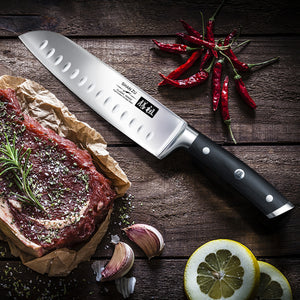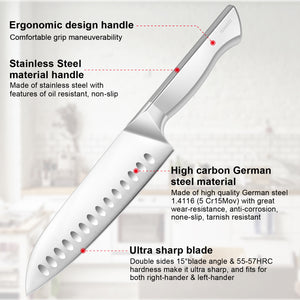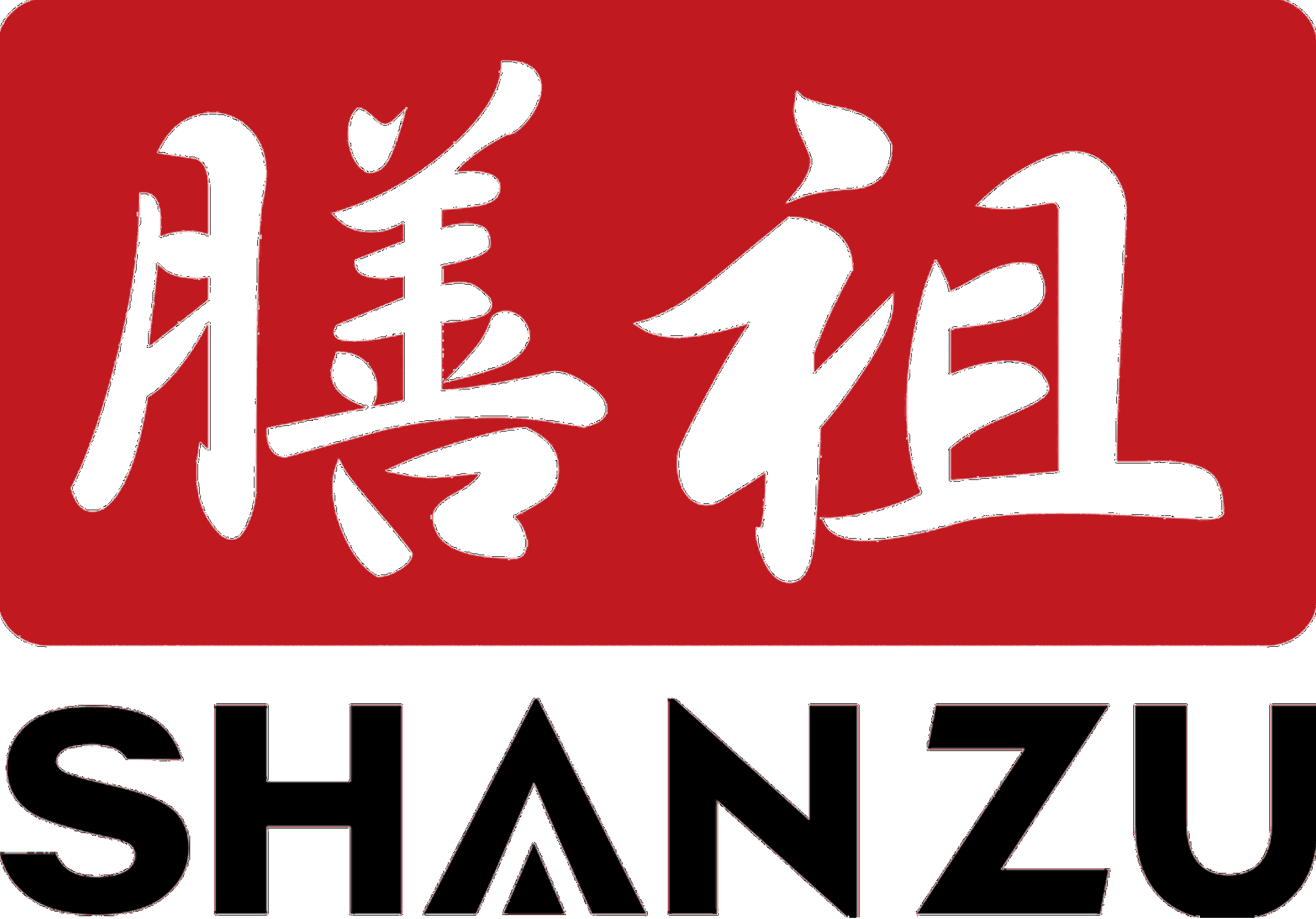What Is a Santoku Knife?

If you are not a professional, then a Santoku knife looks exactly like a chef's knife. Most people mistake Santoku knives for chef's knives quite often. The reason is simple, not only are they similar in appearance, but they also perform the same purpose. It is essentially a multi-purpose knife, one which is used regularly around the kitchen to perform all kinds of chopping and slicing tasks.
Created in Japan during the 1940s, Santoku bocho can be translated into "Three Virtues". The knife is named such due to its versatile nature. It can be used for cutting, slicing, and even chopping. It is this origin that sets it apart from a Chef's knife. Another distinguishing feature between the two is the shape of the blade. Typical Santoku knives are 5 to 8 inches in length, while a Chef knife is longer and usually ranges between 8 to 12 inches in length. When it comes to the blade, Santoku knives have a much wider blade that has a sheep's foot tip. Despite the width, the blade itself is thinner, which allows for better precision.
Simply put, a Santoku is a kitchen knife that does not have a specific use since it can be used for cutting and slicing anything from raw meat to fruits and vegetables. It is made in Japan and is shorter than a Chef's knife with a wider blade that lacks curvature.
What to Look for When Buying a Santoku Knife?
If you are in the market for high-quality Santoku knives, there are a few things to look for. Here are the features you need in a well-made Santoku knife:
Ergonomics & Handle:
Santoku knives are designed specifically for accurate cutting with minimal effort or error. This is why even though the blade is wider in proportion to a Chef knife, the knife is lighter to hold. The knife has a balanced weight since there is no bolster. A Santoku knife is ergonomically better than most knives since it is lighter, which reduces stress while you are using it and makes the knife more agile.
Santoku knives come with different variations of handles, from wooden to metallic and everything in between. When judging the best option, it is always recommended to hold and feel the knife. How well it fits in your hand and the ease of use it provides. Everyone has their preference regarding the weight and shape of the handle; this is why testing out the knife before buying one is a good idea. In most cases, you will be able to determine which knife feels the most comfortable in your hand almost instantly. As for the material of the handle, it also depends on what you prefer. Santoku knives are some of the best knives out there, so there is no doubt about their stupidity. Different handle materials have their pros and cons; like wood is natural and provides a strong grip but can be hard to clean. Alternatively, metal may become slippery when wet, but it is also easy to clean and durable.

Blade Material:
Santoku knives come in a variety of blade materials as well. You can find a Santoku knife made out of ceramic, but it lacks flexibility and is less durable when compared to steel. The best Santoku knives are the ones that have a high-carbon steel blade. Chef's knives usually have a stainless-steel blade, which is sturdy but less so when compared to steel which has a high carbon content. A high-carbon steel blade is forged using a technique that involves hammering a piece of steel to form the blade, and it is this technique that produces a much more durable and sturdy blade when compared to a stainless steel one. So, if you are looking for longevity and durability, then going with a high-carbon steel blade is the most desirable option.

Blade Design:
Santoku knives have a unique blade design, and it is usually this that makes them stand apart from Chef knives. The blade of the Santoku knife is wider and thinner. It is also, in most cases, a single bevel though you can find Santoku knives with double bevels as well. The blade has a straight edge with a curved tip instead of the sharp point found in most Chefs' knives. Santoku knives may have a plain edge or a Granton edge, which has indentations. Look out for these key characteristics in the blade design when buying your Santoku knife to be sure that you are buying an authentic one and not an imitation.
One key thing to note when buying a Santoku knife is to check for the sharpness of the blade. You must make sure that the blade of the knife is sharp from the get-go. If you get one that is already sharpened, you will not need to sharpen the blade, which will improve the longevity of the knife.
What is the difference between a Chef's knife and a Santoku knife?
It is easy to confuse the chef's knife with the Santoku knife. The two are similar in appearance and function. This makes it hard to tell them apart. If you know what to look for, however, telling Santoku knives apart from chef's knives is not hard.
Santoku knives are made in Japan, while most chef's knives originate from either Germany or France. In terms of appearance, Santoku knives are shorter and have a wider blade that is thinner than the blade on a Chef knife. The blade is specially fashioned around the shape of a sheep's foot, and the tip does not have a sharp point.
Chef's knives come with a double bevel, so either side can be used for cutting. Compared to this, Santoku knives usually come in a single level, so they are only sharp on one side. Another differentiating feature is the way the handle is connected to the blade. Santoku knives do not have a piece of metal, known as a bolster, connecting the blade with the handle that is present in chef's knives.
Main Features of a Santoku Knife
To summarize the basic features of Santoku knives, it is important to note that these knives originate from Japan. They are multifunctional, a characteristic that is clear from the name of the knife since Santoku means "three virtues". The knife can be used for cutting, dicing, slicing, and mincing fruits, vegetables, meat, or poultry.
Length
The length of the knife is around 5 inches to 8 inches, which is a reasonable length, long enough for decent grip yet short enough to allow for accurate handling.
Weight
Santoku knives are lightweight and easy to hold and use. This feature also makes it comfortable to use the knife for long periods without causing stress to the hand or implementing unnecessary pressure.
Blade
The blade is also shorter and wider for greater control, while the blade is thinner for more precision cutting. Furthermore, the shape of the Santoku knife's blade has a unique sheep's foot shape with a straight edge and curved tip. The tip does not have a sharp point, so there is no possibility of accidentally puncturing the food that is being prepared. This makes it easy to use even by amateur chefs and home cooks.
Other features include single or double bevel edge, which may be smooth or Granton. The blade and handle do not have a bolster in between, which is a design feature that adds to the sturdiness and ergonomics of the knife.
Material
The material of the blade is a high-carbon steel that I extremely strong and can withstand much more pressure without bending, rusting, or becoming blunt.
If you own a Santoku knife, then you know just how useful it is as a vital kitchen tool. It performs multiple tasks and is just the right size that anyone can handle. You do not need to be a trained professional to maneuver a Santoku knife.
How We Test It?
Testing out any blade is highly recommended. Not every knife suits everyone; this may be due to its design features or utility, or both. Since Santoku knives are supposed to be used on a variety of food items, it is best to test them on different surfaces. Here are the various tests we conducted using Santoku knives on a range of different materials to gauge their prowess and performance. The results were as follows:
Test 1: Paper
Paper is a challenging material to work with. It is thin; it is flimsy and allows for little resistance in holding its shape, which makes it difficult to get an accurate cut. The blade of a Santoku knife is so sharp and thin that it can slice through a single sheet of paper without any problems. The cut is clean and smooth. There are no uneven edges as the blade runs through paper like butter. It is truly unprecedented since paper is not typical material for kitchen knives, and they are not designed to cut through it. Santoku knives' ability to slice paper with such precision is a testament to their ingenious design.
Test 2: Vegetables
Santoku knives are the best tool for cutting, dicing, chopping, or slicing vegetables. The knife works just as well on large and hard-to-cut vegetables like pumpkins or cabbage and works just as well on smaller ones, like cucumber, carrots, and peppers. Since the blade is thin, it is possible to get exceptional thin slices of any vegetable. Whether you want to cut vegetables in thick, chunky pieces or dainty, thin ones, a Santoku knife can be used to achieve the desired results.

Test 3: Meat
Like mutton, pork, and beef, meat presents a challenge when cutting. This is because meat, whether raw or cooked, is much tougher than either poultry or vegetables. Meats also include fats that can be hard to isolate or difficult to cut through due to their gelatinous consistency.
Santoku knives work well on meats perfectly. The blade is sharp and thin and allows for a clean cut.

Test 4: Fish
Handling and cutting seafood is an art, one that the Santoku knife can handle expertly. Santoku knives come from Japan, a nation that loves its seafood. It is no surprise then that the knife can work well for cutting and preparing fish. Even when the fish is wet and slippery, the design of the handle allows for a good grip that prevents the hand from slipping. You can get clean cuts of any type of fish using the Santoku knife.
FAQs About Santoku Knives
1. Should I buy a Santoku vs. chef's knife?
You can buy either; it depends upon your preference. Both are similar when It comes to functionality. The Santoku knife does have the edge of being a lighter and user-friendly knife. So, if you are a beginner or amateur cook, then the Santoku knife is most likely a better option for you.

2. What should I use a Santoku knife for?
Anything. The Santoku knife is a versatile kitchen tool. It is great for cutting and slicing vegetables, poultry, meat, and fruits. It is good for general-purpose food prep. For specific tasks like deboning or carving meats, you will need a specialty knife.

3. What are the dimples on a Santoku knife?
The dimples found on some Santoku knives are accurately known as the Granton edge. This patented design feature performs a very important purpose as the scalloped or indented edges of the knife prevent the blade from sticking to the food being cut. Moist food, like wet fish or meat, can be very sticky, and this may interfere with the cutting process. These dimples make it easy to cut the food with speed and efficiency.

4. Are Santoku and chef blades the same size?
The sizes of the Santoku knives' blades and the chef's knives' blades vary slightly. Typically, the blade of a Santoku knife is anywhere from 5 inches to 8 inches long. On the other hand, the length of a Chef's knife's blade is 8 inches to 12 inches long.
5. How do I clean my Santoku knife?
Cleaning your knife after use is critical, especially if it is a high-carbon steel blade. Wash the knife with a regular dish wash detergent and wipe it dry. Do not wait for it to air dry. Remember to always keep the blade away from acids. Clean immediately after the blade has come into contact with food items with a high acid content and use an alkaline-based soap to rectify the pH levels. Acid is not good for high-carbon stainless steel blades, so extra care must be taken.
6. How do you sharpen a Santoku knife?
The best way to sharpen Santoku knives is the old-fashioned way, which is using a whetstone. Begin by putting the whetstone in water. First, sharpen the coarse edge, if it is a double bevel knife, by running the blade up and down the whetstone at an angle. Be sure to sharpen along the entire edge of the blade.
7. Besides a Santoku knife, what other knives do I need?
It depends on your usage and skill level. If you are making food for yourself and your family, then a simple yet versatile knife like the Santoku knife is good enough. It is also good to have a paring knife around to handle more delicate tasks. If you need dedicated knives on the regular, like a carving knife, then buy it since you will be using it often.





Comments (0)
There are no comments for this article. Be the first to leave a message !